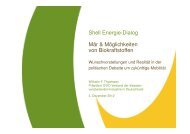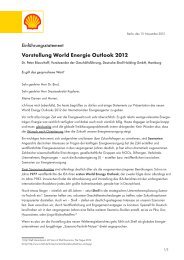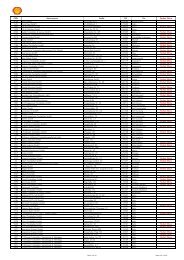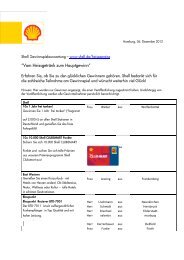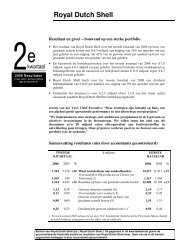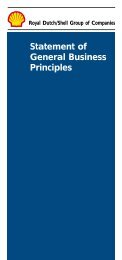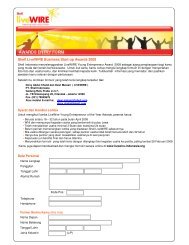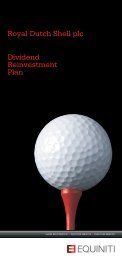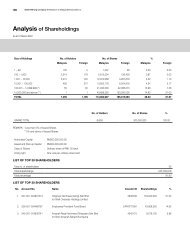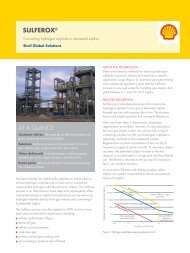Process safety in shell
Process safety in shell
Process safety in shell
You also want an ePaper? Increase the reach of your titles
YUMPU automatically turns print PDFs into web optimized ePapers that Google loves.
<strong>Process</strong> <strong>safety</strong><br />
<strong>in</strong> <strong>shell</strong><br />
our assets are safe and we know it<br />
Given the nature of the risks <strong>in</strong>volved, ensur<strong>in</strong>g the <strong>safety</strong> and <strong>in</strong>tegrity of our<br />
assets is paramount to Shell. For us, process <strong>safety</strong> means mak<strong>in</strong>g sure our facilities<br />
are well designed, safely operated, and properly <strong>in</strong>spected and ma<strong>in</strong>ta<strong>in</strong>ed.<br />
We aim to prevent process <strong>safety</strong> <strong>in</strong>cidents that could place our people, our<br />
neighbours, the environment and our facilities at risk. Put simply, we aim to ensure<br />
that our assets are safe and we know it.<br />
<strong>Process</strong> <strong>safety</strong> <strong>in</strong> Shell<br />
1
2 <strong>Process</strong> <strong>safety</strong> <strong>in</strong> Shell<br />
ManaG<strong>in</strong>G HSSE – a SyStEMatic aPProacH<br />
to achieve cont<strong>in</strong>uous performance improvement<br />
<strong>shell</strong> companies manage health, <strong>safety</strong>, security,<br />
environment and social performance <strong>in</strong> a<br />
systematic way.<br />
At Shell, we aim to help meet the energy needs of society<br />
<strong>in</strong> ways that are economically, environmentally and socially<br />
responsible. To manage the impact of our operations and<br />
projects on the environment and society we have a<br />
comprehensive set of bus<strong>in</strong>ess pr<strong>in</strong>ciples and rigorous<br />
standards cover<strong>in</strong>g health, <strong>safety</strong>, security, environment<br />
(HSSE) and social performance (SP).<br />
Our bus<strong>in</strong>ess pr<strong>in</strong>ciples provide high-level guidance, and the<br />
Commitment and Policy on HSSE & SP reflects our aims on how<br />
we operate and <strong>in</strong>volve communities close to our operations.<br />
Those aims <strong>in</strong>clude:<br />
n do no harm to people;<br />
n protect the environment; and<br />
n comply with all HSSE laws and regulations.<br />
HSSE & SP control framework<br />
All Shell companies, contractors and jo<strong>in</strong>t ventures under our<br />
operational control must manage HSSE and SP <strong>in</strong> l<strong>in</strong>e with the<br />
Commitment and Policy. To help our staff and contractors to put<br />
the Commitment and Policy <strong>in</strong>to practice we launched the<br />
Shell HSSE & SP Control Framework <strong>in</strong> 2009. It is a s<strong>in</strong>gle,<br />
mandatory source for rules cover<strong>in</strong>g areas such as process<br />
and road <strong>safety</strong>. While the Control Framework was launched<br />
<strong>in</strong> 2009 its standards and manuals <strong>in</strong>clude all of the HSSE<br />
requirements we have followed <strong>in</strong> the past, such as our<br />
<strong>in</strong>dustry-first biodiversity standard.<br />
Our focus on compliance <strong>in</strong>cludes tackl<strong>in</strong>g the cultural issues<br />
that can lead to unsafe behaviour. This <strong>in</strong>cludes our efforts to<br />
re<strong>in</strong>force our mandatory 12 Life-Sav<strong>in</strong>g Rules with all employees<br />
and contractors who work for us. We also hold annual global<br />
<strong>safety</strong> days for employees and contractors to reflect on their role<br />
<strong>in</strong> mak<strong>in</strong>g Shell a safer place to work.<br />
<strong>shell</strong>.com/standards<br />
<strong>shell</strong>.com/<strong>safety</strong>
ManaG<strong>in</strong>G ProcESS SaFEty riSK<br />
We identify the hsse risks associated with our<br />
bus<strong>in</strong>ess activities and work to reduce these risks<br />
through mitigat<strong>in</strong>g controls.<br />
Hav<strong>in</strong>g strong controls for process <strong>safety</strong> and asset <strong>in</strong>tegrity risks<br />
at our facilities is critical.<br />
Bus<strong>in</strong>ess managers <strong>in</strong> Shell are accountable for identify<strong>in</strong>g HSSE<br />
hazards, assess<strong>in</strong>g and document<strong>in</strong>g their potential impact, and<br />
reduc<strong>in</strong>g or elim<strong>in</strong>at<strong>in</strong>g risks us<strong>in</strong>g controls and recovery<br />
measures.<br />
One of the ways we are build<strong>in</strong>g a strong <strong>safety</strong> culture<br />
throughout our organisation is by focus<strong>in</strong>g on compliance.<br />
With the launch of our HSSE & SP Control Framework <strong>in</strong> 2009<br />
(see page 2) we released a new <strong>Process</strong> Safety manual, which<br />
builds on our previous standards.<br />
the ‘Bow tie’ Model<br />
The ‘Bow Tie’ Model illustrates the importance of both preventive and recovery measures <strong>in</strong><br />
deal<strong>in</strong>g with risk. Risk is def<strong>in</strong>ed as the likelihood that a Top Event (hazard release) will<br />
occur, comb<strong>in</strong>ed with the severity of the consequences of the event:<br />
H<br />
A<br />
Z<br />
A<br />
R<br />
D<br />
THREAT<br />
CONTROL<br />
BARRIERS<br />
Prevention<br />
■ keep with<strong>in</strong> control limit<br />
■ reduce likelihood<br />
Top<br />
Event<br />
SCENARIO<br />
RECOVERY<br />
MEASURES<br />
Mitigation<br />
■ mitigate consequences<br />
■ plan for recovery/re-<strong>in</strong>state<br />
Risk Management Responses<br />
<strong>Process</strong> <strong>safety</strong> <strong>in</strong> Shell<br />
We audit our bus<strong>in</strong>esses and seek assurance that process <strong>safety</strong><br />
requirements have been implemented and are effective. We<br />
also have a dedicated team of process <strong>safety</strong> experts that assist<br />
<strong>in</strong> audit<strong>in</strong>g our operations and facilities. We regularly report on<br />
process <strong>safety</strong> matters to the Board of Royal Dutch Shell plc.<br />
Our process <strong>safety</strong> performance is cont<strong>in</strong>ually improv<strong>in</strong>g.<br />
For example, the number and volume of operational spills<br />
have fallen s<strong>in</strong>ce 1998 through clear procedures and consistent<br />
compliance. We have a mandatory process to review and<br />
learn from <strong>in</strong>cidents and develop measures to prevent future<br />
recurrences.<br />
CONSEQUENCE<br />
CONSEQUENCE<br />
CONSEQUENCE<br />
hazard: Potential to cause harm.<br />
threat: A possible cause that will potentially release a hazard and produce<br />
a ‘Top Event’.<br />
control Barriers: Measure to prevent threats from releas<strong>in</strong>g a hazard.<br />
top event: The ‘release’ of the hazard, i.e. the first consequence.<br />
recovery Measures: Limit the consequences aris<strong>in</strong>g from Top Event.<br />
consequence: Event(s) that result from the release of a hazard.<br />
3
4 <strong>Process</strong> <strong>safety</strong> <strong>in</strong> Shell<br />
DESiGn <strong>in</strong>tEGrity<br />
<strong>shell</strong> has compiled more than 350 design and<br />
eng<strong>in</strong>eer<strong>in</strong>g practices. these practices reflect the<br />
many years of <strong>shell</strong> experience apply<strong>in</strong>g <strong>in</strong>dustry<br />
design and eng<strong>in</strong>eer<strong>in</strong>g standards and design<br />
codes <strong>in</strong> a safe and reliable manner.<br />
We have mandatory technical standards for design and<br />
construction that are used for explor<strong>in</strong>g, drill<strong>in</strong>g, produc<strong>in</strong>g,<br />
process<strong>in</strong>g, transport<strong>in</strong>g or stor<strong>in</strong>g hazardous substances or<br />
energy. A rigorous process is <strong>in</strong> place to monitor and review<br />
the acceptability of any deviations from these mandatory<br />
technical standards, and to manage change.<br />
<strong>Process</strong> <strong>safety</strong> management<br />
Design<br />
<strong>in</strong>tegrity<br />
<strong>in</strong>tegrity<br />
leaDershiP<br />
oPerat<strong>in</strong>g<br />
<strong>in</strong>tegrity<br />
technical<br />
<strong>in</strong>tegrity<br />
Shell also prescribes mandatory technical standards relat<strong>in</strong>g to<br />
process <strong>safety</strong> requirements. Our standards are <strong>in</strong>formed by<br />
recommendations aris<strong>in</strong>g from <strong>in</strong>dustry <strong>in</strong>cident <strong>in</strong>vestigations,<br />
such as the Baker Report on the Texas City <strong>in</strong>cident. This<br />
<strong>in</strong>cluded guidance on safe sit<strong>in</strong>g of occupied portable<br />
build<strong>in</strong>gs and avoid<strong>in</strong>g liquid release relief to atmosphere.<br />
We perform process <strong>safety</strong> reviews for new facilities and for<br />
modifications of facilities. We also perform regular reviews<br />
of exist<strong>in</strong>g facilities to assess changes made, <strong>in</strong>clud<strong>in</strong>g the<br />
application of new design and eng<strong>in</strong>eer<strong>in</strong>g standards, new<br />
technology, operational experience and lessons learned<br />
from <strong>in</strong>cidents.
aSSEt <strong>in</strong>tEGrity<br />
We prevent process <strong>safety</strong> <strong>in</strong>cidents by ma<strong>in</strong>ta<strong>in</strong><strong>in</strong>g<br />
our hardware barriers and by work<strong>in</strong>g with<strong>in</strong><br />
operational barriers.<br />
Asset <strong>in</strong>tegrity and process <strong>safety</strong> are high priorities for Shell.<br />
We aim to operate all assets, regardless of age or location,<br />
<strong>in</strong> a way that meets or exceeds our <strong>in</strong>ternal standards and<br />
relevant legal and regulatory requirements<br />
Shell cont<strong>in</strong>ues to <strong>in</strong>vest <strong>in</strong> ma<strong>in</strong>ta<strong>in</strong><strong>in</strong>g and improv<strong>in</strong>g the<br />
<strong>safety</strong> and reliability of our operations. This <strong>in</strong>cludes a more<br />
than $5 billion dollar program <strong>in</strong> our upstream bus<strong>in</strong>ess to<br />
improve equipment.<br />
<strong>Process</strong> <strong>safety</strong> <strong>in</strong> Shell<br />
We have detailed ma<strong>in</strong>tenance and <strong>in</strong>tegrity programmes <strong>in</strong><br />
place to keep cont<strong>in</strong>ued focus on the technical <strong>in</strong>tegrity of our<br />
facilities. This <strong>in</strong>cludes mak<strong>in</strong>g sure pre-def<strong>in</strong>ed barriers to<br />
prevent <strong>in</strong>cidents are well ma<strong>in</strong>ta<strong>in</strong>ed and controlled.<br />
Our procedures focus on clarity of expectations, transparency<br />
and open communication with staff. We ensure our managers<br />
and staff know and understand safe operational limits and<br />
operat<strong>in</strong>g procedures and that we have rigorous asset<br />
monitor<strong>in</strong>g protocols.<br />
Shell Eastern Petrochemical complex (SEPc), S<strong>in</strong>gapore 2010,<br />
Separation columns at night Perdido deep water project, Gulf of Mexico, USa, 2010<br />
5
6 <strong>Process</strong> <strong>safety</strong> <strong>in</strong> Shell<br />
<strong>in</strong>tEGrity LEaDErSHiP<br />
leaders play an important role <strong>in</strong> avoid<strong>in</strong>g<br />
process <strong>safety</strong> <strong>in</strong>cidents and must demonstrate<br />
visible and felt leadership <strong>in</strong> the field.<br />
For each life cycle phase of a facility, a Shell manager is<br />
accountable for process <strong>safety</strong> management. All of our<br />
managers have the technical and professional qualifications<br />
and experience required for such a position. They understand<br />
the hazards present <strong>in</strong> their facilities and the barriers available<br />
to reduce process <strong>safety</strong> risk.<br />
We expect our managers to demonstrate leadership <strong>in</strong> process<br />
<strong>safety</strong>. They communicate regularly with staff to ensure process<br />
<strong>safety</strong> expectations and accountabilities are clear. They are<br />
also responsible for ensur<strong>in</strong>g that <strong>in</strong>cidents are <strong>in</strong>vestigated,<br />
and for tak<strong>in</strong>g corrective action and shar<strong>in</strong>g learn<strong>in</strong>gs.<br />
air monitor<strong>in</strong>g at the Phenol 3 Unit, Deer Park ref<strong>in</strong>ery, Houston, USa 2006<br />
Our managers help ensure that our facilities are safe and fit<br />
to operate. For example, a manager will not start or re-start<br />
a facility without follow<strong>in</strong>g a detailed set of <strong>safety</strong> criteria. This<br />
<strong>in</strong>cludes mak<strong>in</strong>g sure employees and contractors are competent<br />
and that procedures are <strong>in</strong> place to operate equipment with<strong>in</strong><br />
def<strong>in</strong>ed operational limits.<br />
We have a company-wide approach for engag<strong>in</strong>g local<br />
communities near our facilities. We use contributions from<br />
community panels and open days to understand their concerns<br />
about the <strong>safety</strong> of our facilities and provide <strong>in</strong>formation on<br />
the measures <strong>in</strong> place to prevent <strong>in</strong>cidents.<br />
Gas Storage norg, netherlands, 2010
cautionary note<br />
The companies <strong>in</strong> which Royal Dutch Shell plc directly and <strong>in</strong>directly owns <strong>in</strong>vestments are<br />
separate entities. In this publication “Shell”, “Shell group” and “Royal Dutch Shell” are sometimes<br />
used for convenience where references are made to Royal Dutch Shell plc and its subsidiaries<br />
<strong>in</strong> general. Likewise, the words “we”, “us” and “our” are also used to refer to subsidiaries<br />
<strong>in</strong> general or to those who work for them. These expressions are also used where no useful<br />
purpose is served by identify<strong>in</strong>g the particular company or companies. ‘‘Subsidiaries’’,<br />
“Shell subsidiaries” and “Shell companies” as used <strong>in</strong> this publication refer to companies <strong>in</strong><br />
which Royal Dutch Shell either directly or <strong>in</strong>directly has control, by hav<strong>in</strong>g either a majority of<br />
the vot<strong>in</strong>g rights or the right to exercise a controll<strong>in</strong>g <strong>in</strong>fluence. The companies <strong>in</strong> which Shell has<br />
significant <strong>in</strong>fluence but not control are referred to as “associated companies” or “associates”<br />
and companies <strong>in</strong> which Shell has jo<strong>in</strong>t control are referred to as “jo<strong>in</strong>tly controlled entities”.<br />
In this publication, associates and jo<strong>in</strong>tly controlled entities are also referred to as “equityaccounted<br />
<strong>in</strong>vestments”. The term “Shell <strong>in</strong>terest” is used for convenience to <strong>in</strong>dicate the direct<br />
and/or <strong>in</strong>direct (for example, through our 34% sharehold<strong>in</strong>g <strong>in</strong> Woodside Petroleum Ltd.)<br />
ownership <strong>in</strong>terest held by Shell <strong>in</strong> a venture, partnership or company, after exclusion of all<br />
third-party <strong>in</strong>terest.<br />
This publication conta<strong>in</strong>s forward-look<strong>in</strong>g statements concern<strong>in</strong>g the f<strong>in</strong>ancial condition, results of<br />
operations and bus<strong>in</strong>esses of Royal Dutch Shell. All statements other than statements of historical<br />
fact are, or may be deemed to be, forward-look<strong>in</strong>g statements. Forward-look<strong>in</strong>g statements are<br />
statements of future expectations that are based on management’s current expectations and<br />
assumptions and <strong>in</strong>volve known and unknown risks and uncerta<strong>in</strong>ties that could cause actual<br />
results, performance or events to differ materially from those expressed or implied <strong>in</strong> these<br />
statements. Forward-look<strong>in</strong>g statements <strong>in</strong>clude, among other th<strong>in</strong>gs, statements concern<strong>in</strong>g the<br />
potential exposure of Royal Dutch Shell to market risks and statements express<strong>in</strong>g management’s<br />
expectations, beliefs, estimates, forecasts, projections and assumptions. These forward-look<strong>in</strong>g<br />
statements are identified by their use of terms and phrases such as ‘‘anticipate’’, ‘‘believe’’,<br />
‘‘could’’, ‘‘estimate’’, ‘‘expect’’, ‘‘<strong>in</strong>tend’’, ‘‘may’’, ‘‘plan’’, ‘‘objectives’’, ‘‘outlook’’, ‘‘probably’’,<br />
‘‘project’’, ‘‘will’’, ‘‘seek’’, ‘‘target’’, ‘‘risks’’, ‘‘goals’’, ‘‘should’’ and similar terms and phrases.<br />
There are a number of factors that could affect the future operations of Royal Dutch Shell and<br />
Published June 2010<br />
for further <strong>in</strong>formation visit <strong>shell</strong>.com/<strong>safety</strong><br />
Design and layout by Creative Services The Hague<br />
<strong>Process</strong> <strong>safety</strong> <strong>in</strong> Shell<br />
could cause those results to differ materially from those expressed <strong>in</strong> the forward-look<strong>in</strong>g<br />
statements <strong>in</strong>cluded <strong>in</strong> this publication, <strong>in</strong>clud<strong>in</strong>g (without limitation): (a) price fluctuations <strong>in</strong><br />
crude oil and natural gas; (b) changes <strong>in</strong> demand for the Shell’s products; (c) currency<br />
fluctuations; (d) drill<strong>in</strong>g and production results; (e) reserve estimates; (f) loss of market share<br />
and <strong>in</strong>dustry competition; (g) environmental and physical risks; (h) risks associated with the identification<br />
of suitable potential acquisition properties and targets, and successful negotiation and<br />
completion of such transactions; (i) the risk of do<strong>in</strong>g bus<strong>in</strong>ess <strong>in</strong> develop<strong>in</strong>g countries and<br />
countries subject to <strong>in</strong>ternational sanctions; (j) legislative, fiscal and regulatory developments<br />
<strong>in</strong>clud<strong>in</strong>g regulatory measures address<strong>in</strong>g climate change; (k) economic and f<strong>in</strong>ancial market<br />
conditions <strong>in</strong> various countries and regions; (l) political risks, <strong>in</strong>clud<strong>in</strong>g the risks of expropriation<br />
and renegotiation of the terms of contracts with governmental entities, delays or advancements<br />
<strong>in</strong> the approval of projects and delays <strong>in</strong> the reimbursement for shared costs; and (m) changes<br />
<strong>in</strong> trad<strong>in</strong>g conditions. All forward-look<strong>in</strong>g statements conta<strong>in</strong>ed <strong>in</strong> this publication are expressly<br />
qualified <strong>in</strong> their entirety by the cautionary statements conta<strong>in</strong>ed or referred to <strong>in</strong> this section.<br />
Readers should not place undue reliance on forward-look<strong>in</strong>g statements. Additional factors that<br />
may affect future results are conta<strong>in</strong>ed <strong>in</strong> Royal Dutch Shell’s 20-F for the year ended December<br />
31, 2009 (available at <strong>shell</strong>.com/<strong>in</strong>vestor and www.sec.gov ). These factors also should be<br />
considered by the reader. Each forward-look<strong>in</strong>g statement speaks only as of the date of this<br />
publication, June 2010. Neither Royal Dutch Shell nor any of its subsidiaries undertake any<br />
obligation to publicly update or revise any forward-look<strong>in</strong>g statement as a result of new<br />
<strong>in</strong>formation, future events or other <strong>in</strong>formation. In light of these risks, results could differ materially<br />
from those stated, implied or <strong>in</strong>ferred from the forward-look<strong>in</strong>g statements conta<strong>in</strong>ed <strong>in</strong> this<br />
publication.<br />
The United States Securities and Exchange Commission (SEC) permits oil and gas companies,<br />
<strong>in</strong> their fil<strong>in</strong>gs with the SEC, to disclose only proved reserves that a company has demonstrated<br />
by actual production or conclusive formation tests to be economically and legally producible<br />
under exist<strong>in</strong>g economic and operat<strong>in</strong>g conditions. We may have used certa<strong>in</strong> terms <strong>in</strong> this<br />
publication that SEC’s guidel<strong>in</strong>es strictly prohibit us from <strong>in</strong>clud<strong>in</strong>g <strong>in</strong> fil<strong>in</strong>gs with the SEC. U.S.<br />
Investors are urged to consider closely the disclosure <strong>in</strong> our Form 20-F, File No 1-32575,<br />
available on the SEC website www.sec.gov. You can also obta<strong>in</strong> these forms from the SEC by<br />
call<strong>in</strong>g 1-800-SEC-0330.<br />
7
8 <strong>Process</strong> <strong>safety</strong> <strong>in</strong> Shell


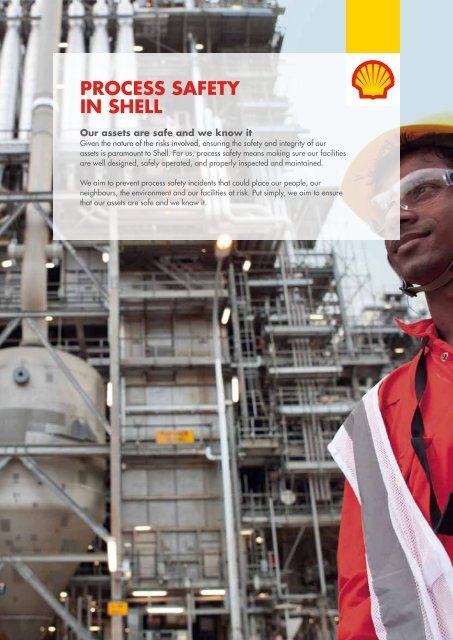
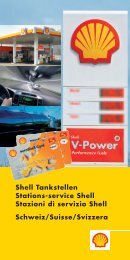
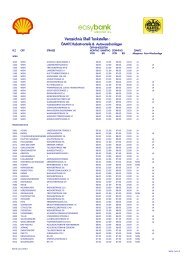
![Download Shell AutoGas Stationen [Stand: Januar 2013] (PDF](https://img.yumpu.com/9982753/1/190x245/download-shell-autogas-stationen-stand-januar-2013-pdf.jpg?quality=85)
